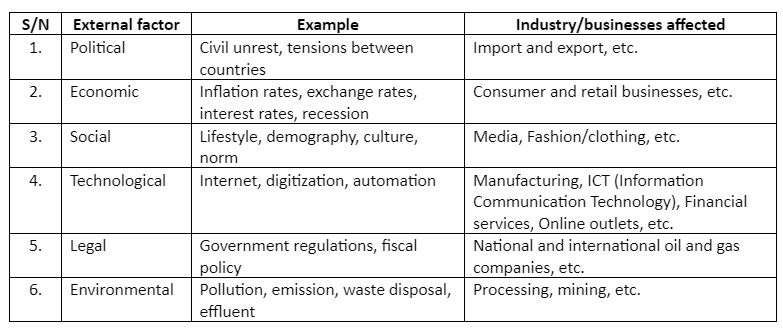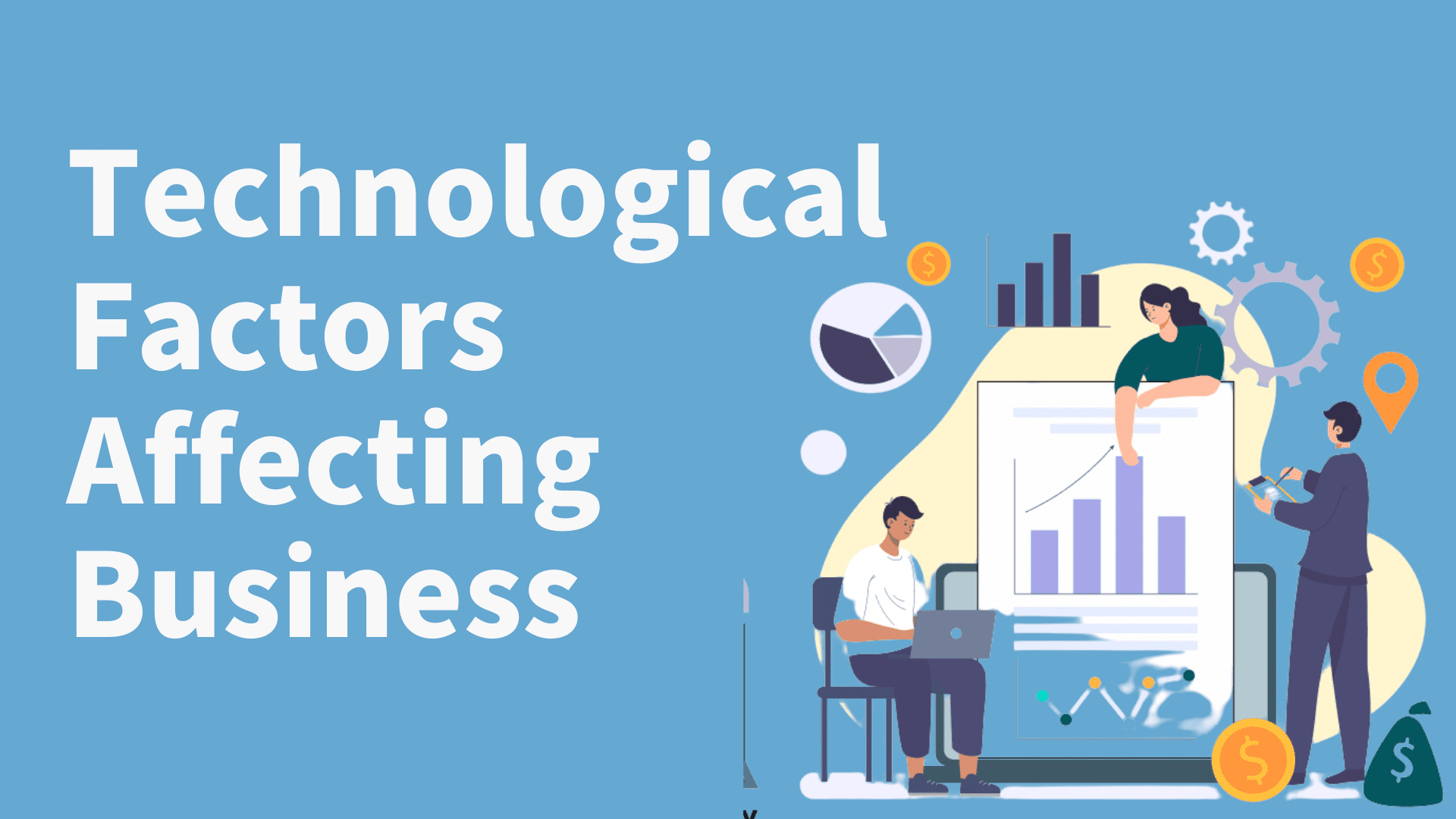This post will discuss the technological factors affecting the business.
The business landscape is constantly in flux, propelled by the dynamic and ever-changing environment. Within this complicated tapestry, numerous factors exert their influence; among them, technological factors hold a prominent position.
The PESTLE analysis is a valuable tool to assess the external forces impacting the business environment comprehensively. PESTLE encompasses a holistic examination of Political, Economic, Social, Technological, Legal, and Environmental factors. Through this lens, businesses gain insights into the diverse opportunities and threats that lie before them.
A poignant illustration of this interplay can be observed in the transformative impact of Netflix on the video rental industry. In the digital era, we find ourselves in places of technological factors at the forefront, showcasing their unparalleled significance in fostering growth and sustainability.
From artificial intelligence and machine learning to robotics process automation and cloud computing, businesses have harnessed these evolving technologies as a competitive advantage, reaping the rewards of enhanced efficiency, cost savings, and superior customer value.
External Factors Affecting a Business
Every business operates within the confines of its surrounding environment. PESTEL analysis has emerged as a widely adopted methodology to understand the intricacies of this external landscape. By meticulously examining political, economic, technological, etc., businesses gain valuable insights into the forces that shape their operations. It is important to note that these factors lie beyond the direct control of any given business.
In today’s interconnected world, the impact of these factors echoes across all facets of business, economy, and society. No longer can any entity exist in isolation. A concrete example of this interdependence can be observed in environmental regulations. With increasing concern for emissions, stringent guidelines and sanctions have been implemented.
For instance, shipping companies are now bound by emission guidelines stipulated under the International Maritime Organization (IMO) Act.
The table below shows a summary of these factors.

Technological Factors Affecting Business
Technology encompasses various ingenious, man-made processes that revolutionize, refine, and give birth to novel goods and services that benefit society. Its realm spans across various remarkable advancements, such as the utilization of robots, software, computers, mobile devices, and more.
In the contemporary digital age, computers and the Internet are the defining pillars shaping the landscape of our daily lives. In particular, businesses have embraced the boundless potential of digital technology, recognizing its ability to drive cost savings and elevate customer experiences to new heights.
A few technological factors are as follows:
Artificial intelligence (AI) and Machine Learning (ML)
These remarkable tools serve a profound purpose in unraveling and foretelling the intricate patterns of customer behavior. Leveraging the power of Artificial Intelligence (AI) and Machine Learning (ML), these dynamic technologies gather invaluable customer data, seamlessly capturing insights during their visits and engagements with a company’s website. This information is then harnessed to decipher individual preferences and discern their aversions.
A shining embodiment of this phenomenon lies within Amazon, the renowned online retail titan. Here, the transformative capabilities of AI technology are harnessed to astutely comprehend user behavior, leading to personalized product recommendations that effortlessly cater to each customer’s unique needs and desires.
Video Conferencing
Businesses leverage the power of video conferencing to establish seamless connections with stakeholders across different geographical locations. Particularly during the challenging times of the Covid-19 pandemic, this invaluable tool emerged as a lifeline, enabling the organization of conferences, seminars, and crucial business meetings through virtual means.
The versatility of this technology extends far and wide, offering many benefits. It facilitates engaging PowerPoint presentations, collaborative reviews of vital business contract documents, the seamless signing of agreements, remote work capabilities, and real-time sharing of crucial data. By harnessing the potential of video conferencing, businesses transcend the barriers of physical distance, fostering effective communication and empowering efficient collaboration.
Online Booking & Payment
The advent of online flight ticket booking has revolutionized how airlines connect with many customers, thanks to the power of digital technology. Moreover, the introduction of secure online payment options has significantly boosted the efficiency and safety of eCommerce transactions, propelling business interactions to new levels of speed and security. Additionally, a fascinating development in the medical industry is the emergence of eDoctor, a groundbreaking concept that allows individuals to virtually engage with healthcare professionals and receive top-notch medical services from the comfort of their homes.
Social Media
Social media has helped businesses tremendously in advertising, campaigns, sales, and marketing. Facebook, for instance, has over two billion monthly active users. This offers business opportunities for wider reach through social media advertising. Studies show impressive return on investment (ROI) for marketing on Facebook.
Virtual Team
In a virtual team, members collaborate seamlessly through the power of technology and the Internet. This innovative approach allows for creating diverse teams comprising individuals working varying shifts, hours, or days within a company. Furthermore, by extending invitations to experts in their respective fields, meetings can be enriched with valuable insights from anywhere around the globe.
Numerous tools now offer advanced features to facilitate online meetings, enabling businesses to tap into the wealth of expertise in different regions. This global perspective fuels enhanced productivity and unlock new possibilities for growth. Additionally, equipment manufacturers can employ virtual interactions to provide exceptional customer support, effectively reducing costs, minimizing travel risks, and saving valuable time for service engineers.
Moreover, virtual teams empower individuals with mobility limitations or disabilities to participate seamlessly in online work. By harnessing the power of virtual collaboration, they can conveniently contribute their skills and talents without the constraints imposed by physical office spaces or the need for specific accessories typically associated with traditional work environments.
Production Technology
Production technology is typical in oil exploration and production. Older technologies, such as seismic sounding, etc., were used in the early days. Years back, no one could boast of commercial hydrocarbon deposits, is now becoming viable using the latest technologies such as MTT (Magento-telluric technology).
This way, oil and gas businesses have discovered and produced more wells.
BIM (Building Information Modeling)
It helps reduce cost and time on construction projects. BIM leverages collaboration amongst building professionals in real-time as against the old way of sharing files. It is a digital representation of a facility’s physical and functional characteristics.
Web Cameras
Web cameras capture projects and make them available on certain websites for stakeholders to view progress, entrenching transparency and accountability. Webcams have helped companies resolve issues amongst people at work as the causes can easily be reviewed.
Digital Twin
The utilization of digital twin technology is prevalent in extensive industrial systems like refineries and production platforms, effectively creating a virtual replica of the actual plant. This powerful tool enables experts to study and program process behavior and strategically plan and predict maintenance and shutdown operations.
Simulating changes to production variables within the digital twin offers a safer and more controlled environment for investigating their effects than experimenting directly on the live process plant.
Online Procurement Tools
These tools have also enabled businesses access to sellers/vendors equally, saving cost and improving satisfaction.
Cloud Computing
Companies are capitalizing on the transformative potential of Cloud Computing (CC) to swiftly and cost-effectively access computing resources while also forging their path into conventional markets. The allure lies in the inherent advantage of CC, which entails a subsidized upfront payment coupled with a flexible pay-as-you-use model.
Cloud infrastructure, software, and application updates can be seamlessly deployed, allowing subscribers to access them iteratively and incrementally. This empowers service providers to effectuate improvements without resorting to the cumbersome process of distributing updated CDs for installation.
Moreover, the pervasive adoption of CC facilitates expedited and cost-efficient outreach to many subscribers. Amazon Web Services (AWS) and Microsoft are prime examples of reputable CC service providers, driving innovation and enabling businesses to harness the limitless possibilities of cloud technology.
Examples of Technological Factors Affecting Business
Examples of a few technological factors that affected Apple and Google are:
- Innovation and New Product Development: Technology serves as the driving force behind innovation and the development of groundbreaking products. Visionary companies like Apple and Google make substantial investments in research and development, ensuring they stay at the vanguard of competition and introduce captivating offerings to the market. A stellar exemplification of this is Apple’s game-changing introduction of the iPhone, which revolutionized the smartphone landscape, and Google’s creation of the Android operating system, propelling it to the forefront of the mobile market.
- Digital Transformation: The ascent of digital technologies has substantially transformed business operations. Pioneering the way Apple and Google harness the potential of digital technologies to streamline their operations, elevate customer experiences, and fuel exponential growth. For instance, Apple’s foray into the digital music domain with iTunes disrupted the traditional music industry, while Google’s suite of digital tools empowers businesses to operate efficiently and reach previously untapped customer segments.
- Cybersecurity: With an escalating reliance on technology, the looming menace of cyber-attacks becomes an ever-growing concern. Apple and Google prioritize investments in cybersecurity to safeguard their customers and fortify their business endeavors against cyber threats. Apple’s steadfast commitment to secure hardware and software architecture has established it as a paragon of security, while Google diligently strives to enhance the security of its products, mitigating the perils posed by cyber-attacks.
- Artificial Intelligence and Machine Learning: Momentous advancements in artificial intelligence (AI) and machine learning (ML) are reshaping myriad industries. Both Apple and Google are making substantial investments in these transformative technologies. Apple’s Siri voice assistant and Google’s Assistant exemplify the power of AI, while Google’s adept utilization of machine learning algorithms empowers personalized search results and bolsters the precision of its predictive models.
Conclusion
Technological factors, as external forces that influence businesses, lie beyond the direct control of their owners. These factors encompass a duality of prospects and perils and can shape a business’s destiny. It is often the case that technology bestows businesses with many opportunities, enabling cost savings and a notable enhancement in operational efficiency.
Any business striving to remain competitive must actively scan the technological landscape and embrace innovation as a key differentiating factor. While there may exist upfront investment costs, the long-term rewards, more often than not, far surpass them when technology is judiciously chosen and seamlessly integrated into the business framework.
